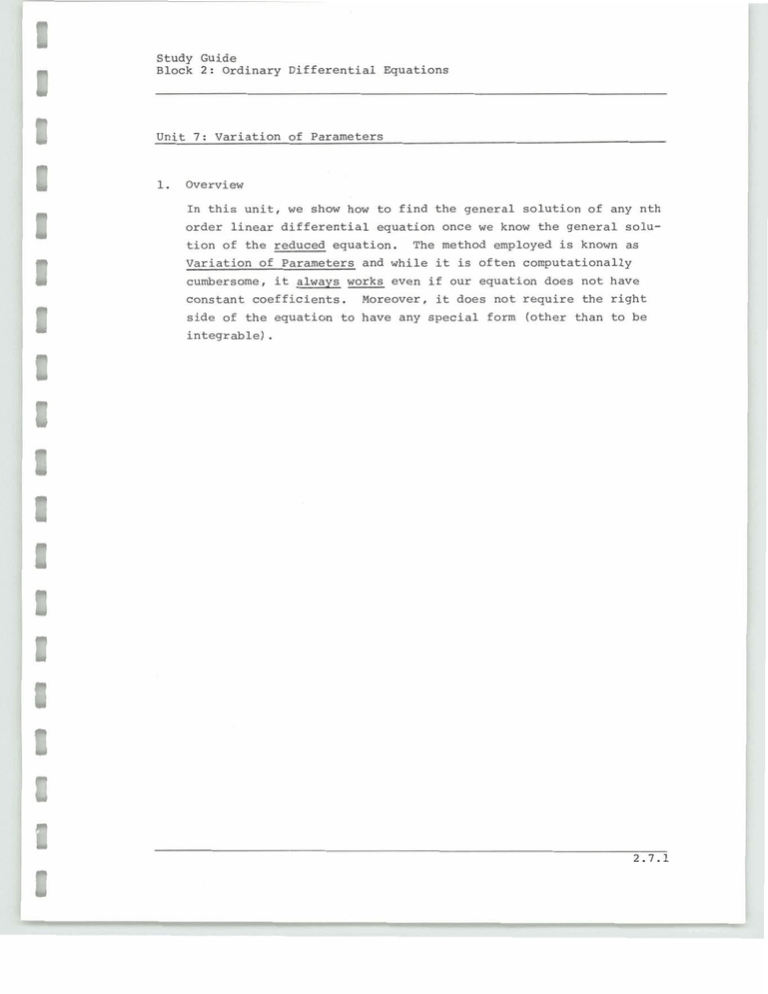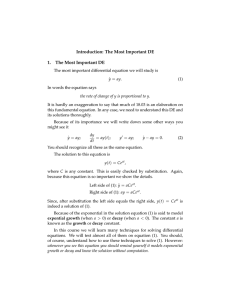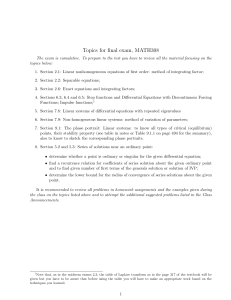Document 13473848
advertisement

Study Guide Block 2: Ordinary Differential Equations Unit 7: Variation of Parameters Overview In this unit, we show how to find the general solution of any nth order linear differential equation once we know the general solution of the reduced equation. The method employed is known as Variation of Parameters and while it is often computationally cumbersome, it always works even if our equation does not have constant coefficients. Moreover, it does not require the right side of the equation to have any special form (other than to be integrable) . Study Guide Block 2: Ordinary Differential Equations Unit 7: Variation of Parameters - -- -- -- we, 4-0 Cbmd -Lhc qmad F O I ~ C ~ ~ A ~"+prt);cqci)~-~c*) use 04 ?.3,&, p ~ 6F. ~ l t m m by ~r 6"h 44 Cln k*~~',, eC prCi*b rol,+,, r " t r ( 3 j 4td3 - .. Study Guide Block 2: Ordinary D i f f e r e n t i a l Equations U n i t 7: V a r i a t i o n of Parameters 3 (Optional) Read Thomas, S e c t i o n s 20.10 and 20.11. (The r e a d i n g m a t e r i a l o f f e r s n o t h i n g d i f f e r e n t from t h e d i s c u s s i o n i n t h e l e c t u r e , b u t what i s i n t e r e s t i n g i s t h a t e v e r y e x e r c i s e l e n d s i t s e l f t o t h e method of undetermined c o e f f i c i e n t s d i s c u s s e d by u s i n t h e p r e v i o u s u n i t . I t might be of i n t e r e s t t o you t o t r y a few of t h e s e e x e r c i s e s , d o i n g them b o t h ways, b u t t h e r e a l v a l u e of t h e method i s i n t h e c a s e where e i t h e r t h e c o e f f i c i e n t s a r e n o t c o n s t a n t o r t h e r i g h t s i d e i s more "complicated.") 4. Exercises : 2.7.1(L) Find a p a r t i c u l a r s o l u t i o n of y" - y = 1 1 + ex' 2.7.2 Find t h e g e n e r a l s o l u t i o n of 2.7.3(L) Suppose w e d i s c o v e r e d t h a t y = x i s a s o l u t i o n of Find a n o t h e r s o l u t i o n of t h i s e q u a t i o n which h a s t h e form y = xg ( x ) where g (x) i s n o t c o n s t a n t . 2.7.4 U s e t h e t e c h n i q u e of E x e r c i s e 2.7.3 y" - t o f i n d a s o l u t i o n of X . 2y' + y = 0 which i s n o t a c o n s t a n t m u l t i p l e of e (We s o l v e d t h i s t y p e of problem i n U n i t 5. T h i s e x e r c i s e s u p p l i e s us w i t h a n o t h e r t e c h n i q u e f o r o b t a i n i n g t h e same r e s u l t , and a l s o s u p p l i e s u s w i t h a d d i t i o n a l d r i l l i n t h e u s e of v a r i a t i o n of parameters. ) Study Guide Block 2: Ordinary Differential Equations Unit 7 : Variation of Parameters 2.7.5 a. By writing in the form find one (non-zero) solution of the equation. b. Use the answer in (a) and the method of Exercise 2 . 7 . 3 to find the general solution of 2.7.6(L) Observing that y = x is a solution of find the general solution of 2.7.7 (Optional) [This problem is not difficult but rather lengthy and perhaps a bit abstract (at least part (a)). The aim is to show how the method of variation of parameters works in higher order equations. If you have time try the entire exercise or at least read the solution. If you are pressed for time but want to get an idea of what is happening, accept the result of part (a) and try to solve (b) using this result. I (continued on next page) 2.7.4 Study Guide Block 2: Ordinary Differential Equations Unit 7: Variation of Parameters 2.7.7 continued is the general solution a. Suppose yh = c1u 1 (x) + c2u2 (x) + c3u3 (x) of L(y) = y"' + p(x)y8' + q(x)yW + r(x)y = 0. Show that = gl (x)ul (x) + g2 (x)u2 (x) + g3 (x)u3 (x) is a particular soluY~ tion of L (y) = f (x) provided that 3 o. Find a particular solution of x y"' + xy' y = x In x (x > 0) knowing that the general solution of the reduced equation is clx + c2x In x + c3x(ln x)2 - . MIT OpenCourseWare http://ocw.mit.edu Resource: Calculus Revisited: Complex Variables, Differential Equations, and Linear Algebra Prof. Herbert Gross The following may not correspond to a particular course on MIT OpenCourseWare, but has been provided by the author as an individual learning resource. For information about citing these materials or our Terms of Use, visit: http://ocw.mit.edu/terms.




